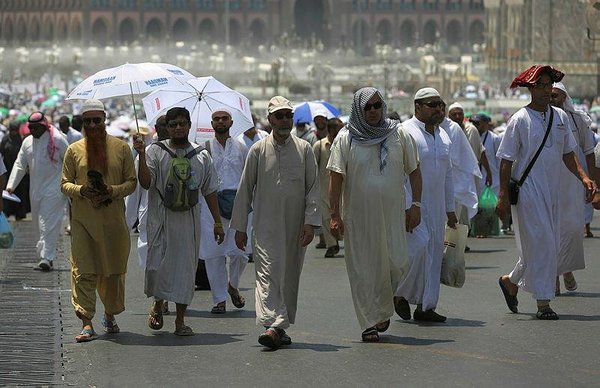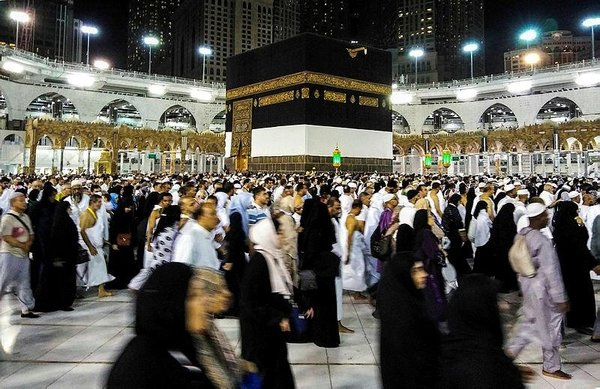More than two million Muslims from around the globe on Sunday started the hajj pilgrimage at Islam's holiest sites in Saudi Arabia, one of the world's largest annual gatherings.
The ultra-conservative kingdom, which is undergoing dramatic social and economic reforms, has mobilised vast resources for the six-day journey, one of the five pillars of Islam.
"It's the dream of every Muslim to come here to Mecca," Frenchman Soliman Ben Mohri said.
"It's the ultimate journey. What worries me is the return to my normal life. For the moment, I am in a dream," the 53-year old told AFP.

Every Muslim is required to complete the hajj at least once in their lifetime if they have the means to do so.
Tens of thousands of security personnel have been deployed for the pilgrimage, which was struck by its worst ever disaster three years ago when around 2,300 worshippers were crushed to death in a stampede.
This year, the Saudis have launched a "smart hajj" initiative, with apps to help pilgrims with everything from travel plans to medical care.
The interior ministry said on Saturday that the number of pilgrims arriving in Mecca had already surpassed the two million mark, mostly from abroad including large contingents from Egypt, India, Pakistan and Bangladesh.

Most of the pilgrims began moving on Sunday from Mecca to the nearby Mina valley where they will spend the night in fire-resistant tents.
Thousands of buses and vehicles carrying the pilgrims lined the eight kilometre (five-mile) road from Mecca to Mina. Many pilgrims made the journey walking under the scorching heat of the sun.
On Monday, pilgrims will climb nearby Mount Arafat for the climax of the hajj, praying and reading the Koran.
The prophet Mohammed delivered his final sermon from Mount Arafat to Muslims who had accompanied him on his final hajj, according to Islam.
After sunset, pilgrims head to Muzdalifah, half-way between Arafat and Mina, where they stay at least until midnight.

They gather pebbles to perform the symbolic stoning of the devil on the eve of the Eid al-Adha feast, which marks the end of hajj.
This year's pilgrimage comes with the oil-flush kingdom witnessing unprecedented change, including an end to a ban on women driving.
While rights campaigners have welcomed the reforms, they have also expressed alarm about a crackdown on dissent.
Although the kingdom's young de facto leader, Crown Prince Mohammed bin Salman, has spearheaded the changes, religion remains a key force in Saudi Arabia.
THE HAJJ PILGRIMAGE AND ITS SIGNIFICANCE IN ISLAM
Over 2 million Muslims from around the world are beginning the five-day hajj pilgrimage on Sunday. They will circle Islam's most sacred site, the cube-shaped Kaaba in the Saudi Arabian city of Mecca, and take part in a series of rituals intended to bring about greater humility and unity among Muslims.
Here's a look at the pilgrimage and what it means for Muslims:
WHAT IS THE PURPOSE OF THE HAJJ?
The hajj is one of the five pillars of Islam, and all able-bodied Muslims are required to perform it once in their lifetime. The hajj is seen as a chance to wipe clean past sins and start fresh. Many seek to deepen their faith on the hajj, with some women taking on the Islamic hair covering known as "hijab" upon returning.
Despite the physical challenges of the hajj, many people rely on canes or crutches and insist on walking the routes. Those who cannot afford the hajj are sometimes financed by charities or community leaders. Others save their entire lives to make the journey. A few even walk thousands of miles by foot to Saudi Arabia, taking months to arrive.
WHAT IS THE HISTORY OF THE HAJJ?
While following a route the Prophet Muhammad once walked, the rites of hajj are believed to ultimately trace the footsteps of the prophets Ibrahim and Ismail, or Abraham and Ishmael as they are named in the Bible.
Muslims believe Ibrahim's faith was tested when God commanded him to sacrifice his only son Ismail. Ibrahim was prepared to submit to the command, but then God stayed his hand, sparing his son. In the Christian and Jewish version of the story, Abraham is ordered to kill his other son, Isaac.
Pilgrims also trace the path of Ibrahim's wife, Hagar, who Muslims believe ran between two hills seven times searching for water for her dying son. Tradition holds that God then brought forth a spring that runs to this day. That spring, known as the sacred well of Zamzam, is believed to possess healing powers, and pilgrims often return from the hajj with bottles of its water as gifts.
WHY IS THE KAABA SO IMPORTANT TO MUSLIMS?
Islamic tradition holds that the Kaaba was built by Ibrahim and Ismail as a house of monotheistic worship thousands of years ago. Over the years, the Kaaba was reconstructed and attracted different kinds of pilgrims, including early Christians who once lived in the Arabian Peninsula. In pre-Islamic times, the Kaaba was used to house pagan idols worshipped by local tribes.
Muslims do not worship the Kaaba, but it is Islam's most sacred site because it represents the metaphorical house of God and the oneness of God in Islam. Observant Muslims around the world face toward the Kaaba during their five daily prayers.
WHAT ARE THE RITUALS PERFORMED DURING THE HAJJ?
Pilgrims enter into a state of spiritual purity known as "ihram" that is aimed at shedding symbols of materialism, giving up worldly pleasures and focusing on the inner self over outward appearance.
Women forgo makeup and perfume and wear loose-fitting clothing and a head covering, while men dress in seamless, white terrycloth garments. The white garments are forbidden to contain any stitching — a restriction meant to emphasize the equality of all Muslims and prevent wealthier pilgrims from differentiating themselves with more elaborate garments.
Muslims are forbidden from engaging in sexual intercourse, cutting their hair or trimming nails while in ihram. It is also forbidden for pilgrims to argue, fight or lose their tempers during the hajj. Inevitably, though, the massive crowds and physical exhaustion of the journey test pilgrims' patience and tolerance.
THE FIRST DAY OF HAJJ
The hajj traditionally begins in Mecca, with a smaller "umrah" pilgrimage which can be performed year-round. To perform the umrah, Muslims circle the Kaaba counter-clockwise seven times while reciting supplications to God, then walk between the two hills traveled by Hagar. Mecca's Grand Mosque, the world's largest, encompasses the Kaaba and the two hills.
Before heading to Mecca, many pilgrims visit the city of Medina, where the Prophet Muhammad is buried and where he built his first mosque.
THE SECOND DAY OF HAJJ
After spending the night in the massive valley of Mina, the pilgrims head to Mount Arafat, some 20 kilometers (12 miles) east of Mecca, for the pinnacle of the pilgrimage.
They scale a hill called Jabal al-Rahma, or Mountain of Mercy. It is here where Muhammad delivered his final sermon, calling for equality and for Muslim unity. He reminded his followers of women's rights and that every Muslim life and property is sacred.
Around sunset, pilgrims head to an area called Muzdalifa, 9 kilometers (5.5 miles) west of Arafat. Many walk, while others use buses. They spend the night there and pick up pebbles along the way that will be used in a symbolic stoning of the devil back in Mina, where Muslims believe the devil tried to talk Ibrahim out of submitting to God's will.
THE FINAL THREE DAYS OF HAJJ
The last three days of the hajj are marked by three events: a final circling of the Kaaba, casting stones in Mina and removing the ihram. Men often shave their heads at the end in a sign of renewal.
The final days of hajj coincide with Eid al-Adha, or the festival of sacrifice, celebrated by Muslims around the world to commemorate Ibrahim's test of faith. During the three-day Eid, Muslims slaughter livestock and distribute the meat to the poor.
THE HAJJ IN NUMBERS
The hajj pilgrimage, which starts at Islam's holiest sites in Saudi Arabia on Sunday, is one of the world's largest annual gatherings.
Here are some figures illustrating its scale:
- More than two million pilgrims are taking part this year, according to official figures, compared to 1.86 million in 2016 and just 24,000 in 1941.
- Some 18,000 civil defence employees, among tens of thousands of security personnel, are helping safeguard pilgrims, officials say. Additionally, thousands of security cameras have been set up along the pilgrimage route.
- Twenty-five hospitals backed by 180 ambulances and more than 30,000 health practitioners have been mobilised to provide emergency services to pilgrims, according to the hajj ministry.
- Tens of thousands of air-conditioned tents have been set up to house pilgrims.
- Around 14,000 international and domestic flights have so far transported pilgrims, according to official figures. Around 21,000 buses have also been used.
- Around 16,000 telecommunication towers and 3,000 WiFi access points have been set up to serve pilgrims, the hajj ministry says.
- Eight million copies of the holy Koran and their translations as well as other religious books will be handed out to pilgrims, official figures show.
- Saudi Arabia hopes to welcome 30 million pilgrims annually in the kingdom by 2030. Muslims also flock to the country for the umra pilgrimage, which can be performed at any time of the year.
- Around 54 million pilgrims have attended the hajj over the past 25 years, according to official figures.